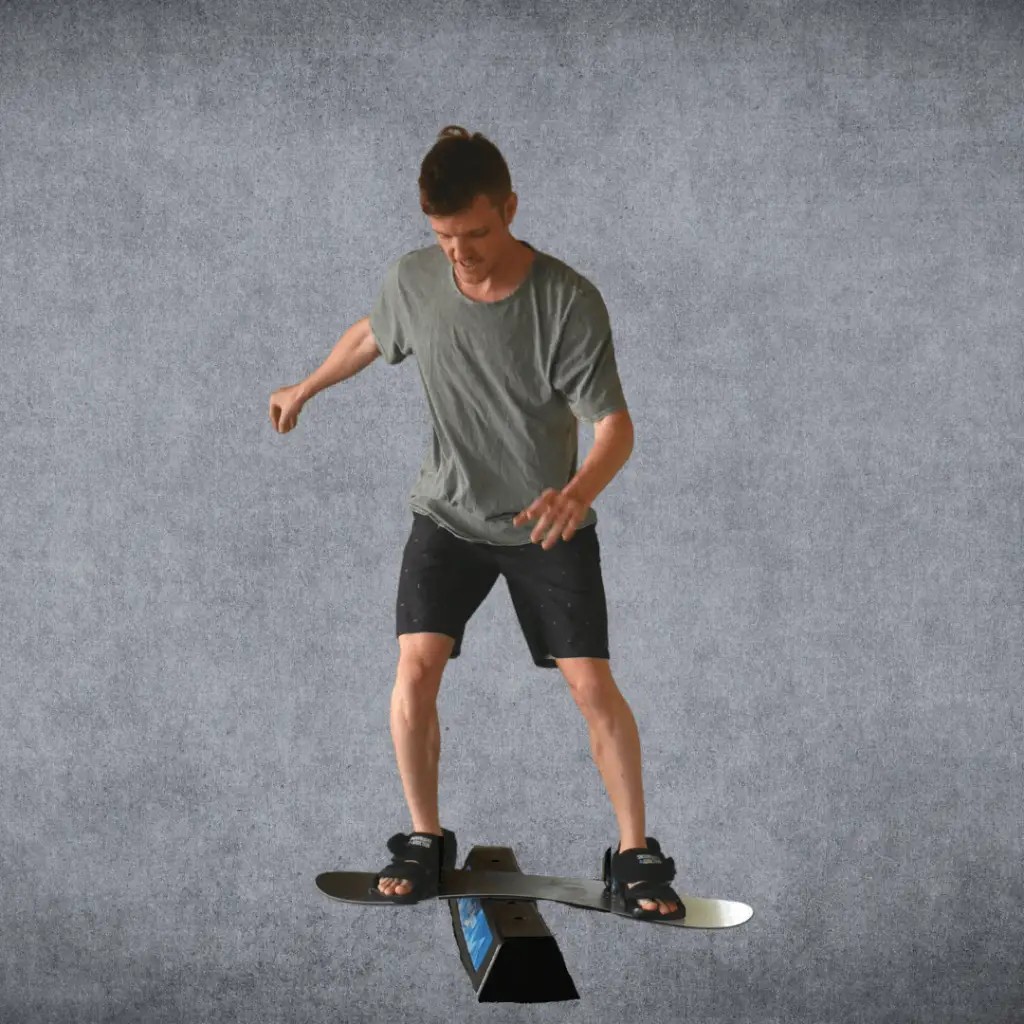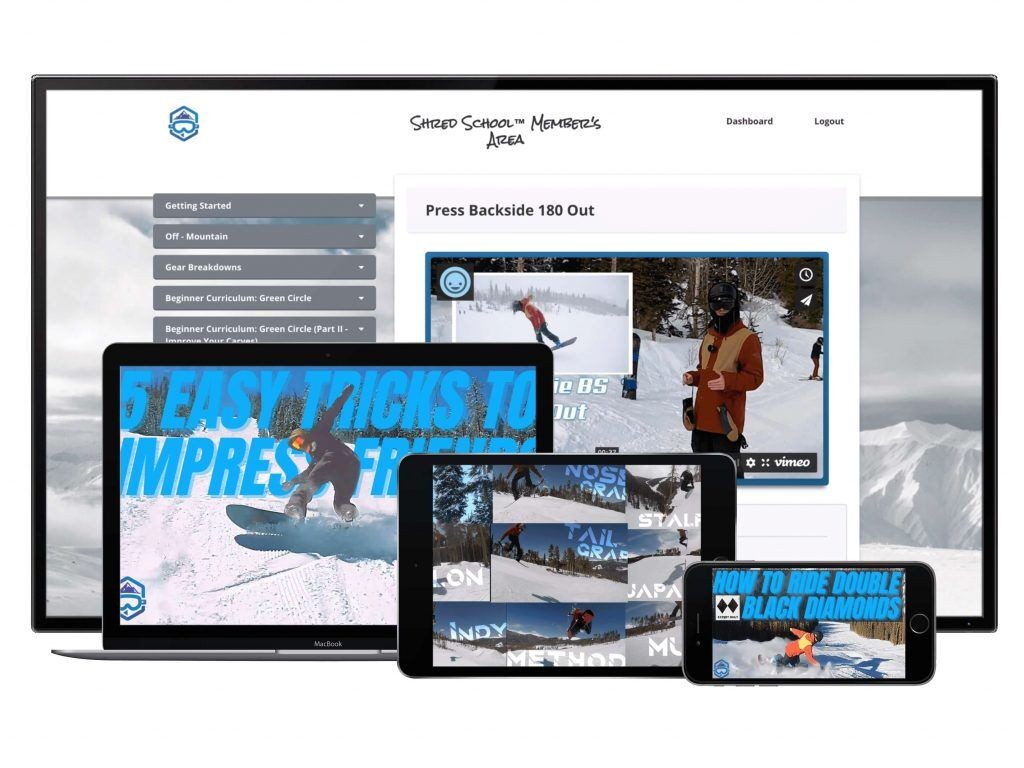Learning how to snowboard at home is achievable with the right approach, significantly boosting your readiness before hitting the slopes, and LEARNS.EDU.VN provides expert guidance to accelerate your progress. Discover essential gear knowledge, balance techniques, and air awareness exercises to enhance your snowboarding skills. Explore LEARNS.EDU.VN for comprehensive tutorials on snowboard preparation and foundational techniques, supplemented by off-season balance training.
Here’s a detailed guide to help you learn to snowboard at home:
1. Mastering Snowboard Gear and Setup at Home
Understanding and properly setting up your snowboard gear is a crucial first step in learning to snowboard, and it can be effectively done at home. Familiarizing yourself with all the equipment involved not only prepares you for the mountain but also enhances your understanding of how each piece contributes to your control and safety.
1.1 Understanding Essential Snowboard Gear
Before even thinking about the slopes, it’s beneficial to get acquainted with all the necessary snowboard gear. This includes your snowboard, bindings, boots, helmet, goggles, and appropriate outerwear. Knowing the purpose and proper fit of each item will ensure you’re well-prepared and comfortable when you eventually hit the mountain.
- Snowboard: Familiarize yourself with the different parts of a snowboard and understand how its shape and size affect performance.
- Bindings: Learn about the different types of bindings and how they attach to the board and your boots.
- Boots: Proper boot fit is crucial for comfort and control. Understand how to tighten and adjust your boots correctly.
- Helmet and Goggles: These are essential for safety. Make sure your helmet fits snugly and your goggles provide clear vision in varying weather conditions.
- Outerwear: Waterproof and breathable outerwear is important for staying warm and dry. Learn about layering techniques to regulate your body temperature.
1.2 Setting Up Your Snowboard at Home
Setting up your snowboard correctly is essential for optimal performance and safety. This involves mounting the bindings at the correct angles and stance width, which can be practiced and adjusted at home.
- Determine Your Stance: Decide whether you will ride regular (left foot forward) or goofy (right foot forward).
- Mount Bindings: Attach your bindings to the board at an angle that feels comfortable. A common starting point is +15 degrees on the front binding and -6 degrees on the rear binding for a beginner.
- Adjust Stance Width: Set the distance between your bindings to match your shoulder width for better balance and control.
- Practice Strapping In: Get used to strapping into your bindings quickly and securely. Practice makes perfect, and being proficient at this will save you time and hassle on the mountain.
1.3 Researching Snowboard Gear Online
Online resources are invaluable for understanding snowboard gear. Websites like LEARNS.EDU.VN offer detailed guides, reviews, and tutorials to help you make informed decisions about your equipment.
- LEARNS.EDU.VN: Provides articles and videos on selecting the right snowboard, boots, and bindings for beginners.
- Snowboard Gear Review Sites: Websites such as “Transworld Snowboarding” and “Snowboarder Magazine” offer in-depth reviews and comparisons of the latest gear.
- Manufacturer Websites: Brands like Burton, Ride, and Salomon provide detailed product information and sizing guides.
1.4 Benefits of Mastering Gear Knowledge
Mastering the gear aspect of snowboarding before hitting the slopes has numerous benefits:
- Saves Time: You’ll spend less time fiddling with your gear on the mountain and more time riding.
- Enhances Comfort: Properly fitted and adjusted gear ensures a more comfortable and enjoyable experience.
- Improves Performance: Understanding how your gear affects your riding allows you to make adjustments that improve your control and stability.
- Increases Safety: Knowing how to properly secure your bindings and wear protective gear reduces the risk of injury.
By dedicating time to learn about and set up your snowboard gear at home, you’ll be well-prepared to tackle the mountain with confidence.
2. Enhancing Balance Skills with Balance Boards and Practice Boards
Balance is fundamental to snowboarding, and you can significantly improve this skill at home using balance boards and practice boards. These tools simulate the movements and balance challenges you’ll encounter on the slopes, helping you develop the necessary stability and coordination.
2.1 Using a Balance Board for Snowboard Training
A balance board is an excellent tool for improving your overall balance and stability. It typically consists of a deck and a roller, challenging you to maintain your balance as you shift your weight. Regular use of a balance board can strengthen your core muscles and improve your reflexes, both of which are crucial for snowboarding.
- Starting Position: Place the balance board on a flat, non-slip surface.
- Mounting the Board: Step onto the board with one foot, then quickly bring the other foot up to maintain balance.
- Maintaining Balance: Use small, controlled movements to keep the board from touching the ground.
- Progression: As you become more comfortable, try different stances and movements, such as squats or rotations.
2.2 Practicing with a Jib Board
A jib board is a snowboard mounted on a stable base, allowing you to practice movements and balance shifts similar to those used in snowboarding. This is particularly useful for simulating the feeling of riding on a snowboard and improving your muscle memory.
- Basic Stance: Practice maintaining your regular snowboard stance on the jib board.
- Weight Shifting: Simulate turns by shifting your weight from edge to edge.
- Balance Drills: Practice balancing on one foot or performing small jumps to improve your stability.
2.3 How Balance Boards and Jib Boards Enhance Snowboarding Skills
Both balance boards and jib boards offer specific benefits that translate directly to improved snowboarding skills:
- Improved Core Strength: Balance exercises engage your core muscles, which are essential for maintaining stability on the slopes.
- Enhanced Coordination: Practicing on these boards improves your coordination and ability to react quickly to changes in balance.
- Better Muscle Memory: By simulating snowboarding movements, you develop muscle memory that makes it easier to perform these actions on the mountain.
- Increased Confidence: As your balance improves, you’ll feel more confident and in control on your snowboard.
2.4 Integrating Balance Training into Your Routine
Consistency is key when it comes to balance training. Incorporate these exercises into your daily routine for the best results:
- Daily Sessions: Aim for 10-15 minutes of balance board or jib board practice each day.
- Warm-Up: Use these exercises as a warm-up before other physical activities.
- Variety: Mix up your routine with different exercises to challenge your muscles in new ways.
By dedicating time to balance training at home, you’ll arrive on the mountain with a solid foundation of stability and control, making your learning experience smoother and more enjoyable.
3. Developing Air Awareness on a Trampoline
Air awareness, or the ability to understand your body’s position in the air, is crucial for snowboarding, especially when performing jumps and tricks. Practicing on a trampoline can significantly improve your air awareness, making you more comfortable and confident when you take to the slopes.
3.1 Benefits of Trampoline Training for Snowboarders
Trampoline training offers several key benefits for snowboarders:
- Improved Body Awareness: Jumping and performing maneuvers on a trampoline helps you become more aware of your body’s position in space.
- Enhanced Coordination: Coordinating movements in the air improves your overall coordination and agility.
- Confidence Building: Successfully executing jumps and tricks on a trampoline can boost your confidence, making you more likely to attempt them on the snow.
- Safe Practice Environment: A trampoline provides a safe environment to experiment with new movements and techniques without the risk of a hard fall.
3.2 Basic Trampoline Exercises for Snowboarders
Start with basic exercises to get comfortable with jumping and moving on a trampoline:
- Basic Jumps: Start with simple vertical jumps to get a feel for the trampoline’s bounce.
- Tuck Jumps: Bring your knees up to your chest during the jump to practice tucking your body.
- Pike Jumps: Keep your legs straight and bend at the waist to touch your toes during the jump.
- 180 and 360 Rotations: Practice rotating your body in the air to improve your spatial awareness.
3.3 Advanced Trampoline Drills for Snowboarders
Once you’re comfortable with the basics, move on to more advanced drills that mimic snowboarding maneuvers:
- Snowboard Grab Simulations: Practice reaching down to grab your snowboard during a jump, simulating grabs like indy, mute, and melon.
- Spin Simulations: Practice spinning in the air, focusing on maintaining your balance and landing smoothly.
- Flip Simulations: If you’re experienced and have proper supervision, you can attempt backflip and front flip simulations.
3.4 Safety Tips for Trampoline Training
- Supervision: Always have a spotter present, especially when attempting new or difficult tricks.
- Clear Space: Make sure the area around the trampoline is clear of obstacles.
- Warm-Up: Perform a thorough warm-up before starting your trampoline session.
- Progression: Gradually increase the difficulty of your exercises as you become more comfortable.
- Proper Equipment: Use a trampoline with safety padding and a net to prevent falls.
By incorporating trampoline training into your snowboarding preparation, you’ll develop the air awareness and confidence needed to tackle jumps and tricks on the mountain with greater ease and safety.
4. Learning Snowboard Techniques Through Videos
Instructional videos are a powerful tool for learning snowboard techniques, providing visual demonstrations and expert advice that can significantly accelerate your learning process. By watching videos, you can familiarize yourself with proper form, common mistakes, and effective strategies before you ever set foot on the slopes.
4.1 Benefits of Using Videos to Learn Snowboarding
- Visual Learning: Videos provide visual demonstrations of techniques, making it easier to understand and replicate the movements.
- Expert Instruction: Many videos feature experienced snowboarders and instructors who offer valuable tips and guidance.
- Convenience: You can watch videos anytime, anywhere, allowing you to learn at your own pace and on your own schedule.
- Cost-Effective: Videos are often free or relatively inexpensive compared to in-person lessons.
4.2 Key Techniques to Learn Through Videos
Focus on videos that cover the following fundamental snowboarding techniques:
- Basic Stance and Balance: Learn the proper stance and weight distribution for maintaining balance on the board.
- Heel Edge and Toe Edge Turns: Understand how to use your edges to control your direction and speed.
- Stopping Techniques: Learn how to safely stop using both heel and toe edges.
- Lift Riding: Get familiar with the process of getting on and off ski lifts.
- Falling Safely: Learn how to fall in a way that minimizes the risk of injury.
4.3 Recommended Video Resources
Explore these online resources for high-quality snowboarding instruction:
- YouTube Channels: Channels like “SnowboardProCamp,” “Ed Shreds,” and “Malcolm Moore” offer comprehensive tutorials for beginners.
- LEARNS.EDU.VN: Provides structured courses and video lessons on snowboarding fundamentals.
- Snowboard Brand Websites: Brands like Burton and Ride often have video tutorials on their websites.
4.4 Maximizing Your Learning from Videos
To get the most out of your video learning experience:
- Take Notes: Jot down key points and tips to help you remember the information.
- Practice Movements: Mimic the movements shown in the videos to develop muscle memory.
- Review Frequently: Watch the videos multiple times to reinforce your understanding.
- Apply on the Mountain: When you’re on the slopes, consciously apply the techniques you’ve learned in the videos.
By using instructional videos as part of your learning strategy, you can build a strong foundation of snowboarding knowledge and accelerate your progress on the mountain.
5. Enhancing Physical Fitness for Snowboarding at Home
Physical fitness plays a significant role in your ability to learn and enjoy snowboarding. Strengthening key muscle groups, improving cardiovascular endurance, and enhancing flexibility can make a noticeable difference in your performance and reduce the risk of injury. Incorporating targeted exercises into your at-home fitness routine can help you prepare your body for the demands of snowboarding.
5.1 Key Areas of Fitness for Snowboarding
- Leg Strength: Strong legs are essential for controlling your board and absorbing impact.
- Core Strength: A strong core helps maintain balance and stability.
- Cardiovascular Endurance: Good cardiovascular fitness allows you to ride longer without getting fatigued.
- Flexibility: Flexibility reduces the risk of muscle strains and improves range of motion.
5.2 Recommended Exercises to Prepare for Snowboarding
- Squats: Strengthen your quads, hamstrings, and glutes, which are essential for maintaining your stance and controlling your board.
- Lunges: Improve balance and stability while working your leg muscles.
- Plank: Engage your core muscles to enhance stability and balance.
- Calf Raises: Strengthen your calf muscles, which are important for edge control.
- Yoga and Stretching: Improve flexibility and range of motion, reducing the risk of injury.
5.3 Sample Weekly Fitness Plan for Snowboarding
| Day | Activity | Description | Duration |
|---|---|---|---|
| Monday | Leg Strength | 3 sets of 10-12 reps of squats, lunges, and calf raises | 45 min |
| Tuesday | Cardio | 30-45 minutes of running, cycling, or swimming | 30-45 min |
| Wednesday | Core Strength | 3 sets of 20-30 seconds of plank, side plank, and Russian twists | 30 min |
| Thursday | Rest or Active Recovery | Light activity such as walking or stretching | 30 min |
| Friday | Leg Strength | 3 sets of 10-12 reps of squats, lunges, and calf raises | 45 min |
| Saturday | Flexibility | 30-45 minutes of yoga or stretching, focusing on hamstrings, quads, and calves | 30-45 min |
| Sunday | Rest | Allow your body to recover and rebuild |


5.4 Tips for Staying Motivated
- Set Goals: Establish specific fitness goals related to snowboarding, such as increasing your endurance or improving your strength.
- Track Progress: Monitor your progress and celebrate your achievements to stay motivated.
- Find a Workout Buddy: Exercising with a friend can make the process more enjoyable and keep you accountable.
- Make it Fun: Choose activities that you enjoy to make fitness a sustainable part of your lifestyle.
By prioritizing physical fitness and incorporating these exercises into your routine, you’ll be better prepared to handle the physical demands of snowboarding, allowing you to learn faster, ride longer, and enjoy your time on the mountain to the fullest.
These comprehensive strategies offer a well-rounded approach to learning snowboarding at home, covering gear, balance, air awareness, technique, and fitness. By following these tips, you’ll be well-prepared to hit the slopes and make the most of your snowboarding experience.
Ready to take your at-home snowboarding preparation to the next level? Visit LEARNS.EDU.VN for in-depth tutorials, personalized training plans, and expert guidance. Our resources can help you fine-tune your skills and ensure you’re fully prepared to conquer the slopes. Don’t just learn—master the art of snowboarding with LEARNS.EDU.VN.
FAQ: Frequently Asked Questions About Learning to Snowboard at Home
-
What essential gear do I need to start learning to snowboard at home?
Essential gear includes a snowboard, bindings, boots, helmet, goggles, and appropriate outerwear. It’s beneficial to familiarize yourself with each piece of equipment to enhance your understanding of how it contributes to your control and safety.
-
How can I improve my balance for snowboarding at home?
Use a balance board or a jib board. These tools simulate the movements and balance challenges you’ll encounter on the slopes, helping you develop the necessary stability and coordination.
-
What are the benefits of using a balance board for snowboard training?
Balance boards improve core strength, enhance coordination, and build better muscle memory by simulating snowboarding movements. They also increase confidence by improving stability.
-
Why is air awareness important for snowboarding, and how can I develop it at home?
Air awareness is crucial for performing jumps and tricks. You can develop it at home by practicing on a trampoline, which helps you become more aware of your body’s position in space and improves your overall coordination.
-
What are the key benefits of trampoline training for snowboarders?
Trampoline training improves body awareness, enhances coordination, builds confidence, and provides a safe environment to experiment with new movements and techniques.
-
How can instructional videos help me learn snowboarding techniques at home?
Instructional videos provide visual demonstrations, expert advice, and a convenient way to learn proper form and effective strategies before hitting the slopes.
-
What fundamental snowboarding techniques should I focus on learning through videos?
Focus on basic stance and balance, heel edge and toe edge turns, stopping techniques, lift riding, and falling safely.
-
Why is physical fitness important for learning snowboarding?
Physical fitness enhances your ability to learn and enjoy snowboarding by strengthening key muscle groups, improving cardiovascular endurance, and enhancing flexibility. This can lead to improved performance and reduced risk of injury.
-
What exercises can I do at home to prepare for snowboarding?
Recommended exercises include squats, lunges, planks, calf raises, and yoga/stretching. These exercises help strengthen your legs and core, improve balance and stability, and enhance flexibility.
-
How can LEARNS.EDU.VN assist me in learning to snowboard at home?
LEARNS.EDU.VN provides in-depth tutorials, personalized training plans, and expert guidance to fine-tune your skills and ensure you’re fully prepared to conquer the slopes. Our resources can help you master the art of snowboarding.
Address: 123 Education Way, Learnville, CA 90210, United States. Whatsapp: +1 555-555-1212. Website: learns.edu.vn.
